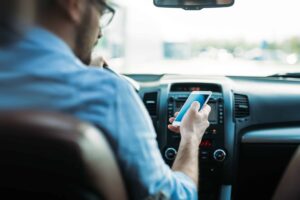With more and more distractions taking up our headspace day-to-day, the increase in distracted driving accidents is not surprising. When it comes to distracted driving facts, there are a lot of misconceptions about what qualifies as distracted driving, how to avoid it, and what to do following distracted driving accidents. See some helpful distracted driving facts below.
How Many Accidents Are Caused by Distracted Driving?
How many accidents are caused by distracted driving? According to the Colorado Department of Transportation, Colorado alone saw 10,166 distracted driving accidents in 2020. That same year, approximately 400,00 people were injured from distracted driving throughout the United States, and 3,142 lives were lost. According to CDOT,
“Multitasking is a myth. A person’s attention can switch back and forth between tasks quickly. Your optimal focus cannot be on two tasks at once. When you’re driving distracted, your attention is diverted from the road ahead, slowing reaction time and, with it, the ability to avoid hazards that can result in a crash.”
Ultimately, these distracted driving facts are used to call attention to a serious issue that you have the power to change. Below, discover the different types of distracted driving, what you can do to avoid these distractions, as well as what you should do if you are in a distracted driving accident.
What to Do After Distracted Driving Accidents

Following distracted driving accidents, it’s important to understand the best course of action to improve your chances of staying safe and avoiding financial loss. If you get into a distracted driving accident, first call 911. This will send first responders to your location so you (or another affected driver) can receive any necessary medical attention. If you are able, document the accident. If another driver is involved, get their driver’s license, insurance, and license plate information. Take photos of the vehicles and document any specific damage.
After speaking with a medical professional, you can get in touch with your own insurance company to set up a claim. While it’s fine to get the ball rolling with your insurance, if the other party’s insurance company tries to get in touch with you, do not provide any information. It’s best to speak with an attorney first. They can handle the conversation with the other party’s insurance or let you know what to do. Once you see a doctor and file a claim, get in touch with a Colorado distracted driving lawyer. Beyond support with insurance, they can help you achieve the best outcomes from the situation.
Distracted Driving Facts: What’s Considered Distracted Driving?
So, what is considered distracted driving? While we all know about texting and driving, there are a few different categories of distracted driving: visual distractions, manual distractions, and cognitive distractions. Often the nature of the distraction can greatly influence a distracted driving case.
Visual Distractions
Visual distractions qualify as anything that takes your eyes away from the road. While a cell phone screen can be considered a visual distraction, it can also be something as simple as a flashy sign. Rubbernecking, or slowing down to look at an accident on the side of the road, is another form of visual distraction, because it takes your eyes from the road ahead and can greatly influence the behaviors of the vehicles around you. The real danger in visual distractions come down to the risk of missing something ahead. Someone in front of you could hit their brakes suddenly, or an animal or piece of debris could go in the road. The conditions around you could change in an instant. So you need to be aware and ready to react to anything.
How to Avoid Visual Distractions
The best way to avoid visual distractions is to always prioritize the road ahead. If you get a phone notification, wait until you park to read it. Don’t slow down traffic when you see a serious accident that’s being handled by first responders. Be safe and respectful of the cars around you – do not use stop lights as an opportunity to accomplish other things or look at social media.
Manual Distractions

Manual distractions include anything that cause you to not have your hands on the wheel. For example, tapping on your phone screen to skip a song or podcast qualifies as manual distractions. Eating while driving takes one hand off the wheel and slows down your reaction time. Rummaging through the glove compartment or holding someone’s hand is also considered manual distraction. Texting while driving is not only a visual distraction, but also a manual distraction. The danger in manual distractions comes down to reaction time. If you don’t have both hands on the wheel, you have less capabilities to respond to things ahead.
How to Avoid Manual Distractions
The best way to avoid manual distractions is to prepare for your drive or let a passenger handle tangible tasks while the car is in motion. Queue up what you’re listening to before you start the trip. This ensures you’re not trying to skip songs or find a good podcast on the highway. When you’re alone in the car, just safely pull over if you need to do something that takes your hand off the wheel. It feels good to kill two birds with one stone and eat breakfast on the way to your destination – but the safest course of action is to do it before you leave or when you get there. Most people don’t even realize how distracted they are from these activities until something gets in the way of the vehicle, and they cannot respond in time.
Cognitive Distractions
Cognitive distractions are distractions that take your mind away from driving. This one is harder to define, because something as simple as daydreaming technically qualifies as a cognitive distraction. Tiredness is also a cognitive distraction, and one of the deadliest forms of distracted driving. Sleep deprivation greatly influences reaction time – it affects your senses and puts you at risk of falling asleep at the wheel. This can lead you to lose control of the car and can cause horrible distracted driving accidents. While this is likely the most severe circumstance, it’s best to always focus entirely on the road ahead. Something as simple as an in-depth conversation or argument can completely take your attention and should probably wait until you get to your destination.
How to Avoid Cognitive Distractions
The best way to avoid cognitive distractions is to create boundaries around your driving. Even if you have hand-free capabilities in your car, save the phone conversation until later. Try to always stay focused on the road ahead. If someone tries to instigate a big conversation, suggest you take a rain check until you’re at home. Never try to drive if you’re too tired. If you’re questioning if you can stay awake for a drive, pull over and call someone to pick you up – or if necessary, pull over to a rest stop and take a nap or check into a hotel for the night. Getting to your destination is never more important than your safety and the safety of the cars around you. Plan ahead and always make sure you’re ready for the ride.
Get Legal Support for Distracted Driving Accidents

If you were involved in a distracted driving accident, CO Trial Lawyers can help. We will equip you with legal distracted driving facts and insights to inform and advise you on the best way to proceed after an accident. As one of the leading Denver distracted driving attorneys, we have the specific expertise to get the best outcomes out of your case. Contact the personal injury lawyers at CO Trial Lawyers today to receive your free case evaluation and get started.

